HLA-DRA
| HLA-DRA | |||||||||||||||||||||||||||||||||||||||||||||||||||
|---|---|---|---|---|---|---|---|---|---|---|---|---|---|---|---|---|---|---|---|---|---|---|---|---|---|---|---|---|---|---|---|---|---|---|---|---|---|---|---|---|---|---|---|---|---|---|---|---|---|---|---|
| |||||||||||||||||||||||||||||||||||||||||||||||||||
| Identifiers | |||||||||||||||||||||||||||||||||||||||||||||||||||
| Aliases | HLA-DRA, HLA-DRA1, MLRW, major histocompatibility complex, class II, DR alpha | ||||||||||||||||||||||||||||||||||||||||||||||||||
| External IDs | OMIM: 142860; MGI: 95900; HomoloGene: 7751; GeneCards: HLA-DRA; OMA:HLA-DRA - orthologs | ||||||||||||||||||||||||||||||||||||||||||||||||||
| |||||||||||||||||||||||||||||||||||||||||||||||||||
| |||||||||||||||||||||||||||||||||||||||||||||||||||
| |||||||||||||||||||||||||||||||||||||||||||||||||||
| |||||||||||||||||||||||||||||||||||||||||||||||||||
| Wikidata | |||||||||||||||||||||||||||||||||||||||||||||||||||
| |||||||||||||||||||||||||||||||||||||||||||||||||||
HLA class II histocompatibility antigen, DR alpha chain is a protein that in humans is encoded by the HLA-DRA gene.[4] HLA-DRA encodes the alpha subunit of HLA-DR. Unlike the alpha chains of other Human MHC class II molecules, the alpha subunit is practically invariable. However it can pair with, in any individual, the beta chain from 3 different DR beta loci, DRB1, and two of any DRB3, DRB4, or DRB5 alleles. Thus there is the potential that any given individual can form 4 different HLA-DR isoforms (2 alleles of DRB1 and two alleles from DRB3, DRB4 or DRB5).
Function
The polypeptide subunit encoded by this gene belongs to the HLA class II alpha chain paralogues. The class II protein is a heterodimer consisting of an alpha (DRα) and a beta chain (DRβ), both anchored in the membrane. It plays a central role in the immune system by presenting peptides derived from extracellular proteins. Class II molecules are expressed in antigen presenting cells (APC: B lymphocytes, dendritic cells, macrophages).[4]
Gene structure and polymorphisms
The alpha chain is approximately 33-35 kDa and its gene contains 5 exons. Exon 1 encodes the leader peptide, exons 2 and 3 encode the two extracellular domains, and exon 4 encodes the transmembrane domain and the cytoplasmic tail. DRA does not have polymorphisms in the peptide binding part and acts as the sole alpha chain for DRB1, DRB3, DRB4 and DRB5.[4]
Alleles
There are two different HLA-DRA chains in the human population coded by three different DRA alleles:
| DRA*01:01 DRA*01:02:01 DRA*01:02:02 |
See also
References
- ^ a b c ENSG00000228987, ENSG00000230726, ENSG00000204287, ENSG00000227993, ENSG00000226260, ENSG00000234794, ENSG00000277263 GRCh38: Ensembl release 89: ENSG00000206308, ENSG00000228987, ENSG00000230726, ENSG00000204287, ENSG00000227993, ENSG00000226260, ENSG00000234794, ENSG00000277263 – Ensembl, May 2017
- ^ "Human PubMed Reference:". National Center for Biotechnology Information, U.S. National Library of Medicine.
- ^ "Mouse PubMed Reference:". National Center for Biotechnology Information, U.S. National Library of Medicine.
- ^ a b c "Entrez Gene: HLA-DRA major histocompatibility complex, class II, DR alpha".
Further reading
- Bénichou S, Benmerah A (2003). "[The HIV nef and the Kaposi-sarcoma-associated virus K3/K5 proteins: "parasites"of the endocytosis pathway]". Med Sci (Paris). 19 (1): 100–6. doi:10.1051/medsci/2003191100. PMID 12836198.
- Tolstrup M, Ostergaard L, Laursen AL, et al. (2004). "HIV/SIV escape from immune surveillance: focus on Nef". Curr. HIV Res. 2 (2): 141–51. doi:10.2174/1570162043484924. PMID 15078178.
- Anderson JL, Hope TJ (2005). "HIV accessory proteins and surviving the host cell". Current HIV/AIDS Reports. 1 (1): 47–53. doi:10.1007/s11904-004-0007-x. PMID 16091223. S2CID 34731265.
- Li L, Li HS, Pauza CD, et al. (2006). "Roles of HIV-1 auxiliary proteins in viral pathogenesis and host-pathogen interactions". Cell Res. 15 (11–12): 923–34. doi:10.1038/sj.cr.7290370. PMID 16354571.
- Stove V, Verhasselt B (2006). "Modelling thymic HIV-1 Nef effects". Curr. HIV Res. 4 (1): 57–64. doi:10.2174/157016206775197583. PMID 16454711.
- Matsushima GK, Itoh-Lindstrom Y, Ting JP (1992). "Activation of the HLA-DRA gene in primary human T lymphocytes: novel usage of TATA and the X and Y promoter elements". Mol. Cell. Biol. 12 (12): 5610–9. doi:10.1128/MCB.12.12.5610. PMC 360500. PMID 1448091.
- Schaiff WT, Hruska KA, McCourt DW, et al. (1992). "HLA-DR associates with specific stress proteins and is retained in the endoplasmic reticulum in invariant chain negative cells". J. Exp. Med. 176 (3): 657–66. doi:10.1084/jem.176.3.657. PMC 2119345. PMID 1512535.
- Piatier-Tonneau D, Gastinel LN, Amblard F, et al. (1991). "Interaction of CD4 with HLA class II antigens and HIV gp120". Immunogenetics. 34 (2): 121–8. doi:10.1007/BF00211424. PMID 1869305. S2CID 10116507.
- Nong Y, Kandil O, Tobin EH, et al. (1991). "The HIV core protein p24 inhibits interferon-gamma-induced increase of HLA-DR and cytochrome b heavy chain mRNA levels in the human monocyte-like cell line THP1". Cell. Immunol. 132 (1): 10–6. doi:10.1016/0008-8749(91)90002-S. PMID 1905983.
- Rosenstein Y, Burakoff SJ, Herrmann SH (1990). "HIV-gp120 can block CD4-class II MHC-mediated adhesion". J. Immunol. 144 (2): 526–31. doi:10.4049/jimmunol.144.2.526. PMID 1967269.
- Callahan KM, Fort MM, Obah EA, et al. (1990). "Genetic variability in HIV-1 gp120 affects interactions with HLA molecules and T cell receptor". J. Immunol. 144 (9): 3341–6. doi:10.4049/jimmunol.144.9.3341. PMID 1970352.
- Bowman MR, MacFerrin KD, Schreiber SL, Burakoff SJ (1991). "Identification and structural analysis of residues in the V1 region of CD4 involved in interaction with human immunodeficiency virus envelope glycoprotein gp120 and class II major histocompatibility complex molecules". Proc. Natl. Acad. Sci. U.S.A. 87 (22): 9052–6. doi:10.1073/pnas.87.22.9052. PMC 55099. PMID 1978941.
- Koppelman B, Cresswell P (1990). "Rapid nonlysosomal degradation of assembled HLA class II glycoproteins incorporating a mutant DR alpha-chain". J. Immunol. 145 (8): 2730–6. doi:10.4049/jimmunol.145.8.2730. PMID 2212658.
- Clayton LK, Sieh M, Pious DA, Reinherz EL (1989). "Identification of human CD4 residues affecting class II MHC versus HIV-1 gp120 binding". Nature. 339 (6225): 548–51. Bibcode:1989Natur.339..548C. doi:10.1038/339548a0. PMID 2543930. S2CID 4246781.
- Diamond DC, Sleckman BP, Gregory T, et al. (1988). "Inhibition of CD4+ T cell function by the HIV envelope protein, gp120". J. Immunol. 141 (11): 3715–7. doi:10.4049/jimmunol.141.11.3715. PMID 2846691.
- Tjernlund U, Scheynius A, Johansson C, et al. (1989). "T-cell response to purified protein derivative after removal of Langerhans' cells from epidermal cell suspensions containing keratinocytes expressing class II transplantation antigens". Scand. J. Immunol. 28 (6): 667–73. doi:10.1111/j.1365-3083.1988.tb01500.x. PMID 3266023. S2CID 25824282.
- Andrieu JM, Even P, Venet A (1986). "AIDS and related syndromes as a viral-induced autoimmune disease of the immune system: an anti-MHC II disorder. Therapeutic implications". AIDS Research. 2 (3): 163–74. doi:10.1089/aid.1.1986.2.163. PMID 3489470.
- Das HK, Lawrance SK, Weissman SM (1983). "Structure and nucleotide sequence of the heavy chain gene of HLA-DR". Proc. Natl. Acad. Sci. U.S.A. 80 (12): 3543–7. Bibcode:1983PNAS...80.3543D. doi:10.1073/pnas.80.12.3543. PMC 394085. PMID 6304715.
- Schamboeck A, Korman AJ, Kamb A, Strominger JL (1984). "Organization of the transcriptional unit of a human class II histocompatibility antigen: HLA-DR heavy chain". Nucleic Acids Res. 11 (24): 8663–75. doi:10.1093/nar/11.24.8663. PMC 326615. PMID 6324094.
- Das HK, Biro PA, Cohen SN, et al. (1983). "Use of synthetic oligonucleotide probes complementary to genes for human HLA-DR alpha and beta as extension primers for the isolation of 5'-specific genomic clones". Proc. Natl. Acad. Sci. U.S.A. 80 (6): 1531–5. Bibcode:1983PNAS...80.1531D. doi:10.1073/pnas.80.6.1531. PMC 393635. PMID 6403940.
- v
- t
- e
-
 1a6a: THE STRUCTURE OF AN INTERMEDIATE IN CLASS II MHC MATURATION: CLIP BOUND TO HLA-DR3
1a6a: THE STRUCTURE OF AN INTERMEDIATE IN CLASS II MHC MATURATION: CLIP BOUND TO HLA-DR3 -
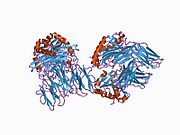 1aqd: HLA-DR1 (DRA, DRB1 0101) HUMAN CLASS II HISTOCOMPATIBILITY PROTEIN (EXTRACELLULAR DOMAIN) COMPLEXED WITH ENDOGENOUS PEPTIDE
1aqd: HLA-DR1 (DRA, DRB1 0101) HUMAN CLASS II HISTOCOMPATIBILITY PROTEIN (EXTRACELLULAR DOMAIN) COMPLEXED WITH ENDOGENOUS PEPTIDE -
 1bx2: CRYSTAL STRUCTURE OF HLA-DR2 (DRA*0101,DRB1*1501) COMPLEXED WITH A PEPTIDE FROM HUMAN MYELIN BASIC PROTEIN
1bx2: CRYSTAL STRUCTURE OF HLA-DR2 (DRA*0101,DRB1*1501) COMPLEXED WITH A PEPTIDE FROM HUMAN MYELIN BASIC PROTEIN -
 1d5m: X-RAY CRYSTAL STRUCTURE OF HLA-DR4 COMPLEXED WITH PEPTIDE AND SEB
1d5m: X-RAY CRYSTAL STRUCTURE OF HLA-DR4 COMPLEXED WITH PEPTIDE AND SEB -
 1d5x: X-RAY CRYSTAL STRUCTURE OF HLA-DR4 COMPLEXED WITH DIPEPTIDE MIMETIC AND SEB
1d5x: X-RAY CRYSTAL STRUCTURE OF HLA-DR4 COMPLEXED WITH DIPEPTIDE MIMETIC AND SEB -
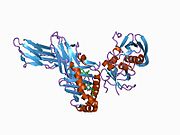 1d5z: X-RAY CRYSTAL STRUCTURE OF HLA-DR4 COMPLEXED WITH PEPTIDOMIMETIC AND SEB
1d5z: X-RAY CRYSTAL STRUCTURE OF HLA-DR4 COMPLEXED WITH PEPTIDOMIMETIC AND SEB -
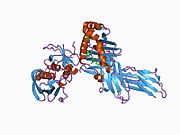 1d6e: CRYSTAL STRUCTURE OF HLA-DR4 COMPLEX WITH PEPTIDOMIMETIC AND SEB
1d6e: CRYSTAL STRUCTURE OF HLA-DR4 COMPLEX WITH PEPTIDOMIMETIC AND SEB -
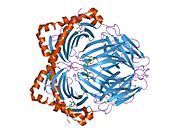 1dlh: CRYSTAL STRUCTURE OF THE HUMAN CLASS II MHC PROTEIN HLA-DR1 COMPLEXED WITH AN INFLUENZA VIRUS PEPTIDE
1dlh: CRYSTAL STRUCTURE OF THE HUMAN CLASS II MHC PROTEIN HLA-DR1 COMPLEXED WITH AN INFLUENZA VIRUS PEPTIDE -
 1fv1: STRUCTURAL BASIS FOR THE BINDING OF AN IMMUNODOMINANT PEPTIDE FROM MYELIN BASIC PROTEIN IN DIFFERENT REGISTERS BY TWO HLA-DR2 ALLELES
1fv1: STRUCTURAL BASIS FOR THE BINDING OF AN IMMUNODOMINANT PEPTIDE FROM MYELIN BASIC PROTEIN IN DIFFERENT REGISTERS BY TWO HLA-DR2 ALLELES -
 1fyt: CRYSTAL STRUCTURE OF A COMPLEX OF A HUMAN ALPHA/BETA-T CELL RECEPTOR, INFLUENZA HA ANTIGEN PEPTIDE, AND MHC CLASS II MOLECULE, HLA-DR1
1fyt: CRYSTAL STRUCTURE OF A COMPLEX OF A HUMAN ALPHA/BETA-T CELL RECEPTOR, INFLUENZA HA ANTIGEN PEPTIDE, AND MHC CLASS II MOLECULE, HLA-DR1 -
 1h15: X-RAY CRYSTAL STRUCTURE OF HLA-DRA1*0101/DRB5*0101 COMPLEXED WITH A PEPTIDE FROM EPSTEIN BARR VIRUS DNA POLYMERASE
1h15: X-RAY CRYSTAL STRUCTURE OF HLA-DRA1*0101/DRB5*0101 COMPLEXED WITH A PEPTIDE FROM EPSTEIN BARR VIRUS DNA POLYMERASE -
 1hqr: CRYSTAL STRUCTURE OF A SUPERANTIGEN BOUND TO THE HIGH-AFFINITY, ZINC-DEPENDENT SITE ON MHC CLASS II
1hqr: CRYSTAL STRUCTURE OF A SUPERANTIGEN BOUND TO THE HIGH-AFFINITY, ZINC-DEPENDENT SITE ON MHC CLASS II -
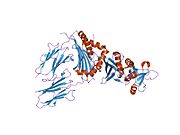 1hxy: CRYSTAL STRUCTURE OF STAPHYLOCOCCAL ENTEROTOXIN H IN COMPLEX WITH HUMAN MHC CLASS II
1hxy: CRYSTAL STRUCTURE OF STAPHYLOCOCCAL ENTEROTOXIN H IN COMPLEX WITH HUMAN MHC CLASS II -
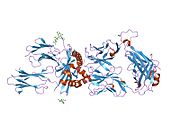 1j8h: Crystal Structure of a Complex of a Human alpha/beta-T cell Receptor, Influenza HA Antigen Peptide, and MHC Class II Molecule, HLA-DR4
1j8h: Crystal Structure of a Complex of a Human alpha/beta-T cell Receptor, Influenza HA Antigen Peptide, and MHC Class II Molecule, HLA-DR4 -
 1jwm: Crystal Structure of the Complex of the MHC Class II Molecule HLA-DR1(HA peptide 306-318) with the Superantigen SEC3
1jwm: Crystal Structure of the Complex of the MHC Class II Molecule HLA-DR1(HA peptide 306-318) with the Superantigen SEC3 -
 1jws: Crystal Structure of the Complex of the MHC Class II Molecule HLA-DR1 (HA peptide 306-318) with the Superantigen SEC3 Variant 3B1
1jws: Crystal Structure of the Complex of the MHC Class II Molecule HLA-DR1 (HA peptide 306-318) with the Superantigen SEC3 Variant 3B1 -
 1jwu: Crystal Structure of the Complex of the MHC Class II Molecule HLA-DR1 (HA peptide 306-318) with the superantigen SEC3 Variant 3B2
1jwu: Crystal Structure of the Complex of the MHC Class II Molecule HLA-DR1 (HA peptide 306-318) with the superantigen SEC3 Variant 3B2 -
 1kg0: Structure of the Epstein-Barr Virus gp42 Protein Bound to the MHC class II Receptor HLA-DR1
1kg0: Structure of the Epstein-Barr Virus gp42 Protein Bound to the MHC class II Receptor HLA-DR1 -
 1klg: Crystal structure of HLA-DR1/TPI(23-37, Thr28-->Ile mutant) complexed with staphylococcal enterotoxin C3 variant 3B2 (SEC3-3B2)
1klg: Crystal structure of HLA-DR1/TPI(23-37, Thr28-->Ile mutant) complexed with staphylococcal enterotoxin C3 variant 3B2 (SEC3-3B2) -
 1klu: Crystal structure of HLA-DR1/TPI(23-37) complexed with staphylococcal enterotoxin C3 variant 3B2 (SEC3-3B2)
1klu: Crystal structure of HLA-DR1/TPI(23-37) complexed with staphylococcal enterotoxin C3 variant 3B2 (SEC3-3B2) -
 1lo5: Crystal structure of the D227A variant of Staphylococcal enterotoxin A in complex with human MHC class II
1lo5: Crystal structure of the D227A variant of Staphylococcal enterotoxin A in complex with human MHC class II -
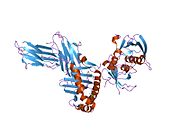 1pyw: Human class II MHC protein HLA-DR1 bound to a designed peptide related to influenza virus hemagglutinin, FVKQNA(MAA)AL, in complex with staphylococcal enterotoxin C3 variant 3B2 (SEC3-3B2)
1pyw: Human class II MHC protein HLA-DR1 bound to a designed peptide related to influenza virus hemagglutinin, FVKQNA(MAA)AL, in complex with staphylococcal enterotoxin C3 variant 3B2 (SEC3-3B2) -
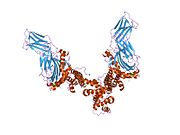 1r5i: Crystal structure of the MAM-MHC complex
1r5i: Crystal structure of the MAM-MHC complex -
 1seb: COMPLEX OF THE HUMAN MHC CLASS II GLYCOPROTEIN HLA-DR1 AND THE BACTERIAL SUPERANTIGEN SEB
1seb: COMPLEX OF THE HUMAN MHC CLASS II GLYCOPROTEIN HLA-DR1 AND THE BACTERIAL SUPERANTIGEN SEB -
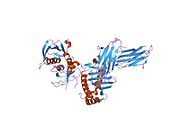 1sje: HLA-DR1 complexed with a 16 residue HIV capsid peptide bound in a hairpin conformation
1sje: HLA-DR1 complexed with a 16 residue HIV capsid peptide bound in a hairpin conformation -
 1sjh: HLA-DR1 complexed with a 13 residue HIV capsid peptide
1sjh: HLA-DR1 complexed with a 13 residue HIV capsid peptide -
 1t5w: HLA-DR1 in complex with a synthetic peptide (AAYSDQATPLLLSPR)
1t5w: HLA-DR1 in complex with a synthetic peptide (AAYSDQATPLLLSPR) -
 1t5x: HLA-DR1 in complex with a synthetic peptide (AAYSDQATPLLLSPR) and the superantigen SEC3-3B2
1t5x: HLA-DR1 in complex with a synthetic peptide (AAYSDQATPLLLSPR) and the superantigen SEC3-3B2 -
 1ymm: TCR/HLA-DR2b/MBP-peptide complex
1ymm: TCR/HLA-DR2b/MBP-peptide complex -
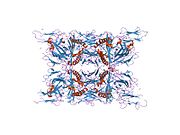 1zgl: Crystal structure of 3A6 TCR bound to MBP/HLA-DR2a
1zgl: Crystal structure of 3A6 TCR bound to MBP/HLA-DR2a -
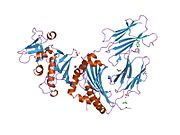 2g9h: Crystal Structure of Staphylococcal Enterotoxin I (SEI) in Complex with a Human MHC class II Molecule
2g9h: Crystal Structure of Staphylococcal Enterotoxin I (SEI) in Complex with a Human MHC class II Molecule -
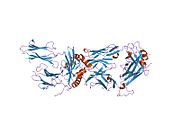 2iam: Structural basis for recognition of mutant self by a tumor-specific, MHC class II-restricted TCR
2iam: Structural basis for recognition of mutant self by a tumor-specific, MHC class II-restricted TCR -
 2ian: Structural basis for recognition of mutant self by a tumor-specific, MHC class II-restricted TCR
2ian: Structural basis for recognition of mutant self by a tumor-specific, MHC class II-restricted TCR -
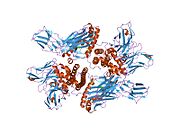 2icw: Crystal structure of a complete ternary complex between TCR, superantigen, and peptide-MHC class II molecule
2icw: Crystal structure of a complete ternary complex between TCR, superantigen, and peptide-MHC class II molecule -
![2ipk: Crystal Structure of the MHC Class II Molecule HLA-DR1 in Complex with the Fluorogenic Peptide, AcPKXVKQNTLKLAT (X=3-[5-(dimethylamino)-1,3-dioxo-1,3-dihydro-2H-isoindol-2-yl]-L-alanine) and the Superantigen, SEC3 Variant 3B2](//upload.wikimedia.org/wikipedia/commons/thumb/a/a9/PDB_2ipk_EBI.jpg/180px-PDB_2ipk_EBI.jpg) 2ipk: Crystal Structure of the MHC Class II Molecule HLA-DR1 in Complex with the Fluorogenic Peptide, AcPKXVKQNTLKLAT (X=3-[5-(dimethylamino)-1,3-dioxo-1,3-dihydro-2H-isoindol-2-yl]-L-alanine) and the Superantigen, SEC3 Variant 3B2
2ipk: Crystal Structure of the MHC Class II Molecule HLA-DR1 in Complex with the Fluorogenic Peptide, AcPKXVKQNTLKLAT (X=3-[5-(dimethylamino)-1,3-dioxo-1,3-dihydro-2H-isoindol-2-yl]-L-alanine) and the Superantigen, SEC3 Variant 3B2 -
 2oje: Mycoplasma arthritidis-derived mitogen complexed with class II MHC molecule HLA-DR1/HA complex in the presence of EDTA
2oje: Mycoplasma arthritidis-derived mitogen complexed with class II MHC molecule HLA-DR1/HA complex in the presence of EDTA -
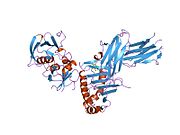 2seb: X-RAY CRYSTAL STRUCTURE OF HLA-DR4 COMPLEXED WITH A PEPTIDE FROM HUMAN COLLAGEN II
2seb: X-RAY CRYSTAL STRUCTURE OF HLA-DR4 COMPLEXED WITH A PEPTIDE FROM HUMAN COLLAGEN II
 | This protein-related article is a stub. You can help Wikipedia by expanding it. |
- v
- t
- e







































![2ipk: Crystal Structure of the MHC Class II Molecule HLA-DR1 in Complex with the Fluorogenic Peptide, AcPKXVKQNTLKLAT (X=3-[5-(dimethylamino)-1,3-dioxo-1,3-dihydro-2H-isoindol-2-yl]-L-alanine) and the Superantigen, SEC3 Variant 3B2](http://upload.wikimedia.org/wikipedia/commons/thumb/a/a9/PDB_2ipk_EBI.jpg/180px-PDB_2ipk_EBI.jpg)











